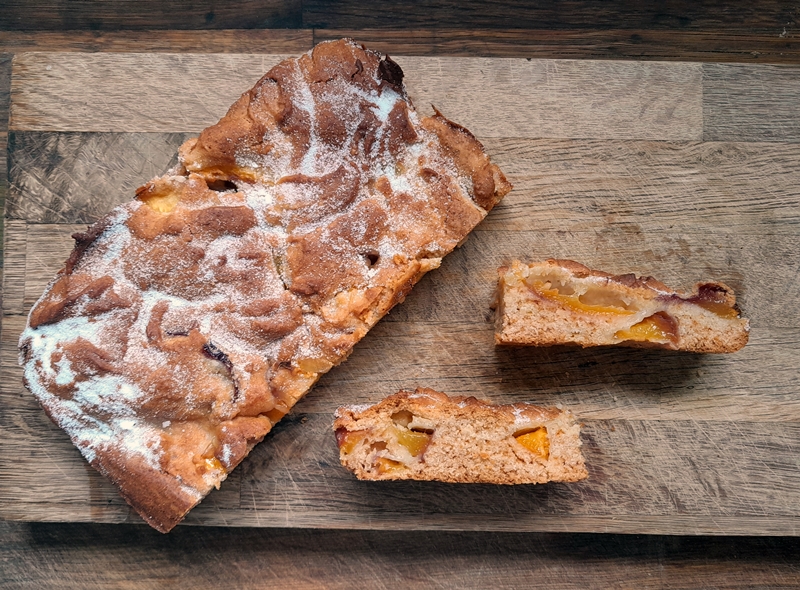Nectarine Cake
Posted: August 5, 2024 Filed under: Cakes, Dairy-free, Desserts, Traditional, vegan, vegetarian | Tags: cake, Dairy-free, egg-free, fresh fruit, pudding, quick, simple, vegan Leave a comment
Wotchers!
The full bounty of summer fruits is upon us, and nectarines and peaches are front and centre in all their golden juiciness.
Except, in all honesty, they aren’t always the peak of perfection. Sometimes you can allow them a few days to mellow and ripen, at which point they’re amazing. And sometimes, all the ripening time in the world isn’t going to get them to that point. Recently in this position, I turned to the internet to find a recipe where my overly-firm nectarines might be turned into something delectable.
I found a recipe for Peach Pound Cake that was much celebrated and re-printed in several magazines and newspapers and had developed something of a reputation for being difficult, as using ripe fruit rendered the resulting cake a quagmire of mush and peach juice. The solution seemed to be perfect for my situation, because the recipe called for firm fruit, which (presumably) would then soften to a flavoursome fruitiness during baking.
So I tried it. Three times. And each time the fruit plummeted, raced even, to the bottom of the pan. Not just a general lower half of the cake, an almost solid layer of fruit pieces, topped by virgin sponge cake. Nothing in my bag of culinary tricks worked. On the bright side, it solved my tray-of-too-hard-nectarines problem, because after all this faffing about I had none left. I probably should have turned them out upside down and brazened it out as being my cunning plan all along (Sidebar: The dud cakes still got served/eaten, they were just unlikely to impress the Lady Mary Berry).
ANYHOO….
Since I hate it when a recipe defeats me, I returned to my own private archive of recipes and hauled out the recipe for a cake which my notes told me was ‘close-textured but not heavy, didn’t rise much in the oven’. I had baked this cake in my shallow 20cm (8 inches in old money) square tin, which I tend to use for tray bakes (as I’ve never been too sure what size a tray bake is supposed to be, but mostly because it’s the tin I that have).
My theory was, in order to prevent the fruit pieces from sliding down through the cake mixture, I would simply remove the possibility to do that, by baking the cake not in a deep, narrow tin, but in a broad, shallow tin: the sooner the cake portion cooks, the sooner the fruit pieces will be supported and held in place. Sidebar: an excellent approach to baking wholemeal bread, by the way, if you don’t mind shallow slices.
This recipe started out as a 19thC gingerbread, so I merely switched out the spice for some vanilla. Its enrichment with ground almonds would ensure it kept moist, as well as making the recipe suitable for adapting to whole range of stone fruit. I really enjoy the close texture of the cake contrasting with the freshness and juiciness of the fruit. Two other features of this cake are of interest: it uses a light syrup, not granulated sugar, for sweetness, and it contains no eggs, thus making it suitable for vegans. If you’re likely to have solid coconut oil in the cupboard, aside from the fruit, you need nothing fresh. Finally, if you weren’t already sold, this recipe qualifies as a pudding cake – a vintage term for sweet recipes that can be eaten hot as a pudding (and delicious with cream), or as a cake when cold (also, unsurprisingly, delicious with cream). It has so much going for it!
Nectarine Cake
Any stone fruit can be used, although you might prefer to skin peaches first. To make this vegan/dairy-free, swap out the butter for coconut oil or block vegetable fat.
400g-ish nectarines (3) or any stone fruit
4tbs/¼ cup cornflour/cornstarch
200g agave nectar/date syrup or other light syrup.
115g unsalted butter/coconut oil/vegetable fat
1tsp vanilla extract
85g ground almonds
60g rice flour
175g plain flour
1 rounded tsp baking powder
- Line a 20cm square tin with baking parchment.
- Heat the oven to 180°C, 160°C Fan.
- Cut the nectarines into quarters, and slice each quarter lengthwise into three. Sift over the cornflour and toss the fruit pieces to coat. The cornflour will absorb any juice during baking and keep the cake from becoming sodden.
- Warm the butter and syrup in a small pan over low heat just until the butter is melted. Add the vanilla extract.
- Sift together the dry ingredients.
- Pour the dry ingredients and the syrup mixture into a bowl and whisk well until light, smooth and fully combined.
- Stir through the fruit and pour into the prepared tin.
- Smooth out the cake mixture and bake for 45 minutes, turning the tin around after 25 minutes to ensure even baking.
- Dust the cake with caster sugar and allow to cool for 10 minutes in the tin.
- Serve warm, or cool completely in the tin and serve cold.
- Store in an airtight container.